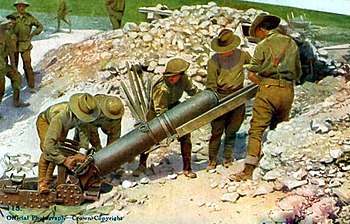9.45 inch Heavy Mortar
| ML 9.45 inch Heavy Trench Mortar | |
|---|---|

Colourised postcard showing Australians loading a mortar near Pozières, August 1916 according to the caption. The absence of a fuze on the bomb and lack of concealment indicates this is a training or publicity photograph away from the front line.
|
|
| Type | Heavy trench mortar |
| Place of origin | France |
| Service history | |
| In service | 1916–1918 |
| Used by | United Kingdom Austria |
| Wars | World War I |
| Production history | |
| Designer | Dumezil-Batignolles |
| Designed | 1915 |
| No. built | 712 |
| Specifications | |
| Weight |
Mortar & elevating gear 499 lb, + body & bed 987 lb (Mk I) 644 lb, + 1169lb (Mk II–IV) |
| Barrel length | 4 ft 3 in (1.30 m) (Mk I) 5 ft 8 in (1.73 m) (Mk II–IV) |
| Crew | 7 |
|
|
|
| Shell | HE 152 pounds (69 kg) |
| Calibre | 9.45 inch (240 mm) |
| Elevation | 75°–45° |
| Traverse | 18° L & R |
| Rate of fire | 1 round every 6 minutes |
| Muzzle velocity | 475 ft/s (145 m/s) max charge |
| Effective firing range | 660–2,400 yards (600–2,190 m) |
| Filling | amatol or ammonal |
Mortar & elevating gear 499 lb, + body & bed 987 lb (Mk I)
The ML 9.45 inch Heavy Trench Mortar, nicknamed the Flying Pig, was a large calibre mortar of World War I and the standard British heavy mortar from the autumn of 1916. It was a modification of an original French design, the Mortier de 240 mm developed by Batignolles Company of Paris and introduced in 1915. Britain manufactured the modified version under licence.
The British ML 9.45-inch (240 mm) mortar was a design based on the French 240 mm mortar in 1915 and introduced in 1916. The British version differed from the French LT weapon in that the propellant charge was loaded through the muzzle whereas the French 240 mm had the charge loaded through the breech in a brass cartridge case.
In June 1916, following unsatisfactory trials with the French model, Britain replaced them with 30 of its own model, firing a 150-pound bomb, followed by 200 more in December 1916.
The Mark I with 51-inch (1,300 mm) barrel was introduced from June 1916. In 1917, the Mark II and Mark III followed with 69-inch (1,800 mm) barrel, and small numbers of Mark IV.
It was operated by crews of the Royal Garrison Artillery which was the part of the British Army that operated the heaviest artillery weapons, formed into batteries of 4 mortars attached to each division, designated "V/nn" where nn = division number. From February 1918 they were reorganised and moved from divisional to corps control.
The weapon was dismantled for transport, requiring 4 carts for the barrel, base, carriage and ammunition.
In action, a heavy timber platform was constructed embedded in the ground, on which the mortar base was immovably secured. The mortar carriage sat on the base and could traverse. The mortar barrel and breech were mounted on the carriage which provided elevation.
...
Wikipedia
